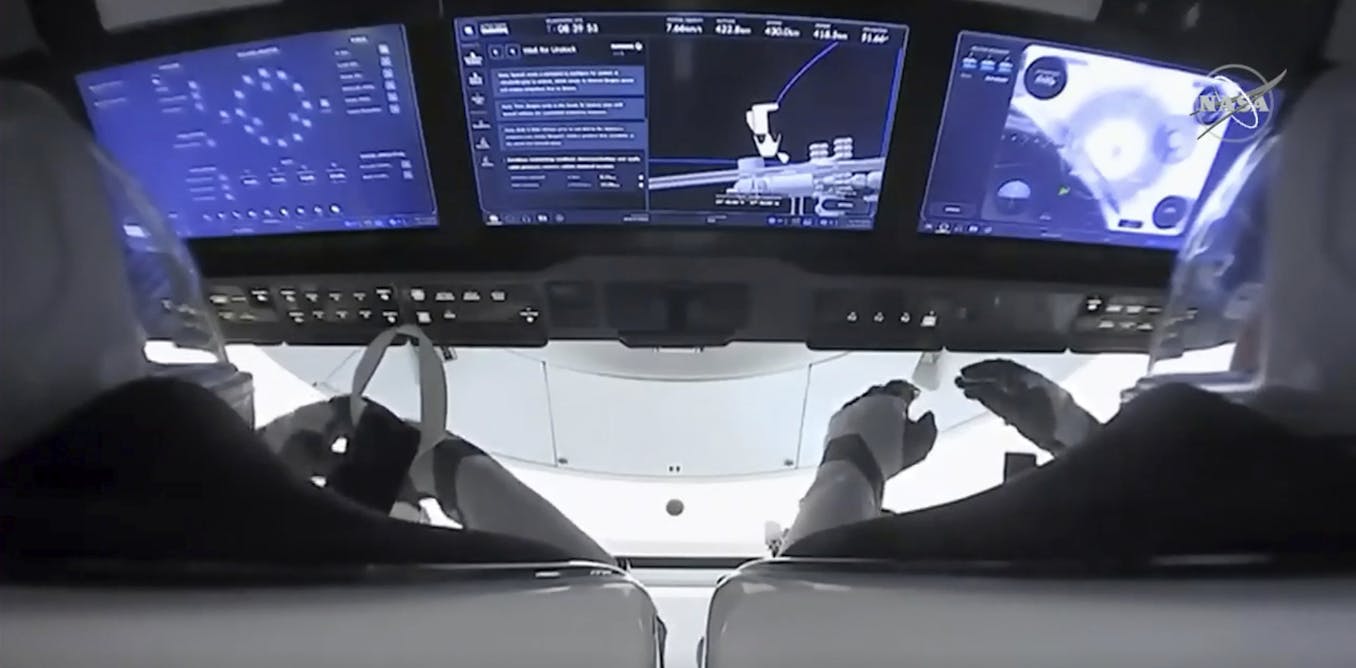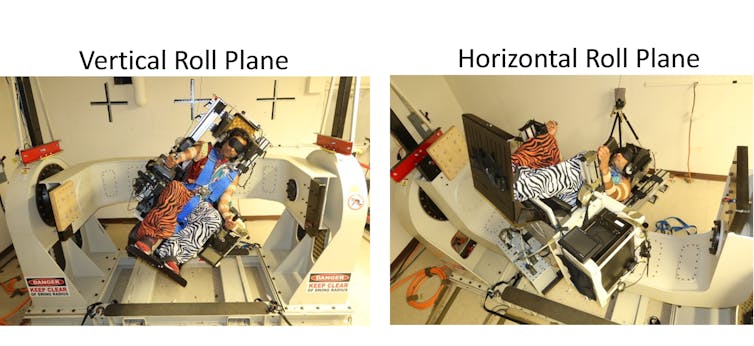
Specialized training programs using sensory augmentation devices could prevent astronauts from getting disoriented in space
When you’re an astronaut landing on the Moon, you can’t rely on the same gravitational cues we have on Earth. But regimented training with sensory devices could one day prevent spatial disorientation.
Nov. 10, 2023 • 10 min • Source
When landing on the surface of the Moon, astronauts can become spatially disoriented, which is when they lose sense of their orientation – they might not be able to tell which way is up. This disorientation can lead to fatal accidents.
Even on Earth, between 1993 and 2013 , spatial disorientation led to the loss of 65 aircraft, US$2.32 billion of damages and 101 deaths in the U.S.
Could wearable technology augment the senses of astronauts, allowing them to overcome the limitations of their biological sensors? And what type of training could build a deeper bond between the astronaut and the wearable technology, so that astronauts would be able to rely on the technology when they can’t trust their own senses?
I am a research scientist in the Ashton Graybiel Spatial Orientation Lab at Brandeis University . With my collaborators, Alexander Panic , James Lackner and Paul DiZio , I study sensory augmentation and spatial disorientation, which is when astronauts and pilots lose the sense of which way they are oriented.
In a paper published in November 2023 in Frontiers in Physiology, we determined whether vibrotactors – small vibrating devices placed on the skin – could enhance the performance of participants put in a disorienting condition that mimicked spaceflight. We also studied what type of training could enhance the connection between the human and the device.
Vibrotactors communicate information through the touch receptors of the somatosensory system instead of the visual system. They have previously helped pilots flying helicopters and airplanes .
When pilots are disoriented, their visual system often gets overwhelmed with information . Vibrotactors can help because they send touch signals rather than visual signals.
Creating a spaceflight analog condition
For our first experiment, we wanted to figure out whether using vibrotactors would improve a particpant’s ability to stabilize themselves in a disorienting spaceflight condition.
We strapped participants into a multi-axis rotation device, which is a machine containing a chair that’s programmed to behave like an inverted pendulum. Like a pencil falling left or right as you try to balance it on your fingertip, the multi-axis rotation device tilts to the left or right. Participants used a joystick to try to balance themselves and keep the chair upright.
We blindfolded the participants, because spatial disorientation often occurs when pilots can’t see – like when they fly at night or through clouds .
On Earth, tiny organs in the inner ears called otoliths help people keep their balance by sensing how far the body is tilted away from an upright position, also called the gravitational vertical. In space and especially during gravitational transitions, such as while landing on a planet or the Moon, the gravitational information detected by the otoliths is very different than on Earth. This can cause disorientation.
Additionally, long-duration spaceflight will change how the brain interprets the signals coming from the otoliths. This can also lead to disorientation when landing.
In our Earth analog condition, which was meant as a control to compare against the spaceflight condition we tested, participants sat in the multi-axis rotation device and used a joystick to stabilize themselves around the balance point. The balance point was at an upright position, or the gravitational vertical.
Because the otoliths can sense tilt from the gravitational vertical, participants always had a good sense of their orientation and the location of the balance point. We called this the Earth analog condition because they could use gravitational cues to do the task. Every participant learned and improved their performance on this over time.
Then, in the spaceflight analog condition, we had the multi-axis rotation device pitch the participants back by 90 degrees. The balance point was still in the center, and the multi-axis rotation device was programmed to tilt to either the left or right while participants were on their back.
In the Earth condition, the balance point was lined up with the upright, so it was easy to use the otoliths to determine how much one was tilted. However, in the spaceflight condition, participants no longer tilted relative to the gravitational vertical, because they were always on their back. So even though the balance point they were trying to find was the same, they could no longer use gravity to determine how much they were tilted from the balance point.
Similarly, astronauts have minimal gravitational cues when initially landing. In our spaceflight condition , the participants showed very poor performance and had high rates of losing control.

For each of the 13 participants in the experimental group, we attached four vibrotactors on each arm. The farther a participant titled from the balance point, the more vibrotactors vibrated on the same side.
We found that vibrotactile feedback helped performance in the disorienting spaceflight condition. But it also led to a feeling of conflict between a participant’s incorrect perception of their orientation and their actual orientation, as indicated by the vibrotactors.
Because of this conflict, the participants’ performance in the spaceflight condition was not as good as it was in the Earth condition.
Surprisingly, even knowing that they were disoriented and reporting high levels of trust in the vibrotactors was not enough to allow people to continue learning and improving their performance. This suggests that cognitive trust, or their self-reported level of trust, may differ than their gut-level trust – and cognitive trust alone does not ensure people will be able to rely on the vibrotactors when disoriented.
Building a human-device bond
Previous research in sensory substitution has found that allowing participants to freely explore and play around with the device during training builds a bond between the human and the device.
In our first experiment, we provided participants with time to explore how the device works. We gave them 40 minutes to explore the vibrotactile feedback in the Earth condition the day before they were tested in the spaceflight condition. While this helped participants perform better than those who did not have vibrotactors, their improvements were modest , and these participants did not show any further improvement in performance after being given 40 minutes in the spaceflight condition.
So, why was this free exploration not enough for our test condition but sufficient for other experiments? One reason could be that the majority of prior studies on sensory augmentation have had the training and testing occur in the same environment. However, astronauts will most likely receive their training on Earth before being in space, where their sensory information will be very different.
To determine whether specialized training could lead to better results, we ran another group of participants through a training program .
Participants spent the first day in the Earth analog condition, where they had to stabilize themselves while searching for hidden balance points that were different than the upright, or gravitational vertical. In order to find the hidden balance point, they had to disengage from their desire to align with the upright while focusing on the vibrotactors, which indicated the location of the balance point.
When this group was tested on Day 2 in the spaceflight analog condition, they performed significantly better than the group that had the vibrotactors but hadn’t received the training program. Our findings suggest that simple exposure to sensory augmentation devices will be not be enough training for astronauts to rely on the device when they cannot rely upon their own senses.
Also, cognitive trust in the device may not be enough to ensure reliance. Instead, astronauts will need specialized training that requires disengaging from one sense while focusing on feedback from the device.
Vivekanand Vimal receives funding from NASA’s Human Research Program under grant 80NSSC22K0758


